John Joseph McVeigh
Gold Member
On January 29, I encountered an intermittent problem with stalling while clearing snow off of my driveway. I had also experienced a bit of stalling over the weekend of January 22-23-24, while clearing the driveway (and that of my elderly neighbors during and after the Make Winter Great Again storm that dropped more than two feet of snow on Northern Maryland.
The problem seemed to occur most often soon after I started climbing a grade. The engine would start to labor. This would happen even if I was moving on a section of driveway that I had already cleared.
If I backed off on the directional speed and disengaged the PTO (if engaged), and reduced the throttle, the engine would sometimes recover after a bit of rough idling. Other times, the engine would die. However, if I cranked the starter, it would immediately catch, sometimes then running smoothly, other times then running roughly until the engine ultimately smoothed out..
I had stalled out a few times on Friday night, January 22, in very low temperatures. At the time, I thought that perhaps there was some waxing of fuel happening. i had added Power Service to the fuel, at single-strength dosage. I noted that evening, when I came in for the night, that the container recommended double-strength dosage when the temperature dropped into the teens. So, I added some Power Service to what was already in the tank, and to what was in the five-gallon fuel can that I would use to fill the fuel tank.
The next day, it was still pretty cold. I could not tell whether the situation was all that much better. I stalled a couple of times, but it seemed less frequently than I had the night before.
The next weekend, the problem seemed to be getting worse. I was blowing snow on the edges of the driveway that I had not gotten to during the storm. The stalling problem was now happening more frequently, again almost always shortly after I started to climb a grade.
Before I had set out, I had checked the fuel filter/water separator in the engine compartment. The fuel in the chamber looked pristine.
The fact that the problem typically happened shortly after I had started climbing an incline got me to thinking that perhaps there was water in the bottom of the fuel tank. So, I added some liquid fuel drier rated for use in diesel engines, plus more Diesel fuel to top off the tank. That did not help.
Then, I remembered that there was a second (first, really) fuel filter, closer to the tank. I had never seen it, but I remembered reading about it in the manual, and had bought a spare from my dealer.
I removed the floor panel to access the filter. The filter medium looked dark, but I thought that perhaps that was due to it being soaked in fuel. I had a spare fuel filter in my bin of Ventrac spares, so I go that out and looked at the medium. It was yellow/brownish in color... typical of filters with a paper filtration medium.
I decided to add some diesel fuel to the filter to see how much the filter medium would change color , so I injected some with a hobby syringe of the type that I normally use to dispense smoke fluid for my model steam locomotives. The filter medium really did not change color all that much.
I decided to remove the original filter and to see if I could examine the fuel in the filtration chamber. I also decided to change the motor oil and oil filter, as I had just hit 200 hours on the hour meter.
While the old oil was draining from the sump. I removed the upstream (closer to the fuel tank) filter from the fuel line, and put it in a small plastic tub that I had positioned below the filter to act as a catch basin. I then lifted the tub, took the filter in hand, and started shaking it up and down to get the trapped fuel flowing into the tub.
Much to my surprise, there was a good bit of foreign material in the fuel that I had liberated from the upstream (pre-filtration, closer to the fuel tank) chamber of the filter. The material included what I suspect was leaf dust. It also included the bodies of several small winged insects.
I had previously noticed that the bottom outer periphery of the filler cap for the fuel tank had several slots in it, and that leaf dust and mowing debris would sometimes build up around those slots. The slots apparently are for venting the tank. Especially during the mowing and leaf-shredding seasons, I would regularly clean the filler cap so that no gunk would fall into the tank when I was removing or replacing the cap. In the winter, I also take care to remove snow so that no snow falls in the tank when I remove or reposition the filler cap.
After replacing the fuel filter, I fired the engine back up. I ran smoothly. I decided to give it a workout. The problem was gone.
So, the cause was partial fuel starvation due to a clogged filter.
I began to think that it might be prudent to fashion a ring of open-cell foam to sit between the underside of the fuel-tank cap and the steel box in which the plastic fuel tank resides. The foam would act as a air filter and as impediment to bugs that otherwise would end up in the fuel tank. I would need to periodically wash that foam ring so that the tank can continue to breathe freely.
I started doing research as to what material I might use for this purpose. I settled on a K&N Model 25-1480 prefilter.. The K&N 25-1480 has a nominal inside diameter of 3 inches. The outer diameter of the filler neck is about 3.5 inches.
I had had some prior experience with K&N products for my 1974 Triumph TR6, to which I had fitted 3x Weber 40DCOE carbureters, among other things (and which sadly succumbed to terminal chassis rot several years later). So, I had some reason to hope that the K&N 25-1480 would have enough ability to stretch that it could compensate for the disparity in diameters without tearing. Yes, the material would be somewhat compressed, and this might impair its breathability a bit, but I thought that the 25-1480 might still be usable for the purpose.
I decided to order a K&N 25-1480 from the local Carquest Store. At the same time, I ordered a K&N 25-3900. The K&N 25-3900 is 48 inches long and 12 or more inches high, and is in the form of a strip that one can cut to size. K&N supplies Velco strips for keeping the prefilter in place. My thinking was that if the K&N 25-1480 ended up being too small, I could cut the K&N 25-3900 to the size needed and have plenty of material left over to make a couple of spares, and a couple of prefilters for other gasoline-power devices.
The K&N prefilters arrived at the local CarQuest on Thursday. I drove up to pick them up. After dinner, I decided to try to fit the K&N 25-1480 to the filler neck. I had to stretch the K&N prefilter a bit, but it did not tear, and I succeeded in getting it on. I did not apply oil to the prefilter before installing it, because the K&N charging oil is very sticky, and I did not want to mess my hands. If the filter seemed to fit, I intended to remove the filter, charge it with K&N oil, and then refit it to the filler neck. However, for starters, I simply wanted to see if it would fit.
It looks as if the K&N 25-1480 will do the trick. Some pictures follow.
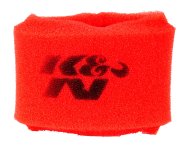
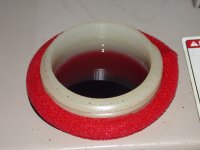
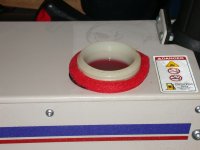
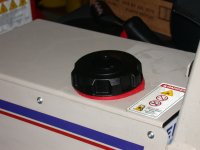
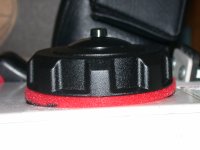
I do not think that this will help owners of gasoline-powered Ventracs because, as I understand it, the filler cap is not vented. The vent slots on the underside of the 4500Y filler cap are fairly large, obviously big enough to let insects crawl into. I know that the insects were not in the fuel cans or in the fuel because I use a screened funnel whenever I fill up the fuel tank.
Have any of you other Ventrac Diesel owners had a similar experience with bugs and mowing and shredding dust getting into the fuel tank through the vents in the filler cap?
The problem seemed to occur most often soon after I started climbing a grade. The engine would start to labor. This would happen even if I was moving on a section of driveway that I had already cleared.
If I backed off on the directional speed and disengaged the PTO (if engaged), and reduced the throttle, the engine would sometimes recover after a bit of rough idling. Other times, the engine would die. However, if I cranked the starter, it would immediately catch, sometimes then running smoothly, other times then running roughly until the engine ultimately smoothed out..
I had stalled out a few times on Friday night, January 22, in very low temperatures. At the time, I thought that perhaps there was some waxing of fuel happening. i had added Power Service to the fuel, at single-strength dosage. I noted that evening, when I came in for the night, that the container recommended double-strength dosage when the temperature dropped into the teens. So, I added some Power Service to what was already in the tank, and to what was in the five-gallon fuel can that I would use to fill the fuel tank.
The next day, it was still pretty cold. I could not tell whether the situation was all that much better. I stalled a couple of times, but it seemed less frequently than I had the night before.
The next weekend, the problem seemed to be getting worse. I was blowing snow on the edges of the driveway that I had not gotten to during the storm. The stalling problem was now happening more frequently, again almost always shortly after I started to climb a grade.
Before I had set out, I had checked the fuel filter/water separator in the engine compartment. The fuel in the chamber looked pristine.
The fact that the problem typically happened shortly after I had started climbing an incline got me to thinking that perhaps there was water in the bottom of the fuel tank. So, I added some liquid fuel drier rated for use in diesel engines, plus more Diesel fuel to top off the tank. That did not help.
Then, I remembered that there was a second (first, really) fuel filter, closer to the tank. I had never seen it, but I remembered reading about it in the manual, and had bought a spare from my dealer.
I removed the floor panel to access the filter. The filter medium looked dark, but I thought that perhaps that was due to it being soaked in fuel. I had a spare fuel filter in my bin of Ventrac spares, so I go that out and looked at the medium. It was yellow/brownish in color... typical of filters with a paper filtration medium.
I decided to add some diesel fuel to the filter to see how much the filter medium would change color , so I injected some with a hobby syringe of the type that I normally use to dispense smoke fluid for my model steam locomotives. The filter medium really did not change color all that much.
I decided to remove the original filter and to see if I could examine the fuel in the filtration chamber. I also decided to change the motor oil and oil filter, as I had just hit 200 hours on the hour meter.
While the old oil was draining from the sump. I removed the upstream (closer to the fuel tank) filter from the fuel line, and put it in a small plastic tub that I had positioned below the filter to act as a catch basin. I then lifted the tub, took the filter in hand, and started shaking it up and down to get the trapped fuel flowing into the tub.
Much to my surprise, there was a good bit of foreign material in the fuel that I had liberated from the upstream (pre-filtration, closer to the fuel tank) chamber of the filter. The material included what I suspect was leaf dust. It also included the bodies of several small winged insects.
I had previously noticed that the bottom outer periphery of the filler cap for the fuel tank had several slots in it, and that leaf dust and mowing debris would sometimes build up around those slots. The slots apparently are for venting the tank. Especially during the mowing and leaf-shredding seasons, I would regularly clean the filler cap so that no gunk would fall into the tank when I was removing or replacing the cap. In the winter, I also take care to remove snow so that no snow falls in the tank when I remove or reposition the filler cap.
After replacing the fuel filter, I fired the engine back up. I ran smoothly. I decided to give it a workout. The problem was gone.
So, the cause was partial fuel starvation due to a clogged filter.
I began to think that it might be prudent to fashion a ring of open-cell foam to sit between the underside of the fuel-tank cap and the steel box in which the plastic fuel tank resides. The foam would act as a air filter and as impediment to bugs that otherwise would end up in the fuel tank. I would need to periodically wash that foam ring so that the tank can continue to breathe freely.
I started doing research as to what material I might use for this purpose. I settled on a K&N Model 25-1480 prefilter.. The K&N 25-1480 has a nominal inside diameter of 3 inches. The outer diameter of the filler neck is about 3.5 inches.
I had had some prior experience with K&N products for my 1974 Triumph TR6, to which I had fitted 3x Weber 40DCOE carbureters, among other things (and which sadly succumbed to terminal chassis rot several years later). So, I had some reason to hope that the K&N 25-1480 would have enough ability to stretch that it could compensate for the disparity in diameters without tearing. Yes, the material would be somewhat compressed, and this might impair its breathability a bit, but I thought that the 25-1480 might still be usable for the purpose.
I decided to order a K&N 25-1480 from the local Carquest Store. At the same time, I ordered a K&N 25-3900. The K&N 25-3900 is 48 inches long and 12 or more inches high, and is in the form of a strip that one can cut to size. K&N supplies Velco strips for keeping the prefilter in place. My thinking was that if the K&N 25-1480 ended up being too small, I could cut the K&N 25-3900 to the size needed and have plenty of material left over to make a couple of spares, and a couple of prefilters for other gasoline-power devices.
The K&N prefilters arrived at the local CarQuest on Thursday. I drove up to pick them up. After dinner, I decided to try to fit the K&N 25-1480 to the filler neck. I had to stretch the K&N prefilter a bit, but it did not tear, and I succeeded in getting it on. I did not apply oil to the prefilter before installing it, because the K&N charging oil is very sticky, and I did not want to mess my hands. If the filter seemed to fit, I intended to remove the filter, charge it with K&N oil, and then refit it to the filler neck. However, for starters, I simply wanted to see if it would fit.
It looks as if the K&N 25-1480 will do the trick. Some pictures follow.





I do not think that this will help owners of gasoline-powered Ventracs because, as I understand it, the filler cap is not vented. The vent slots on the underside of the 4500Y filler cap are fairly large, obviously big enough to let insects crawl into. I know that the insects were not in the fuel cans or in the fuel because I use a screened funnel whenever I fill up the fuel tank.
Have any of you other Ventrac Diesel owners had a similar experience with bugs and mowing and shredding dust getting into the fuel tank through the vents in the filler cap?